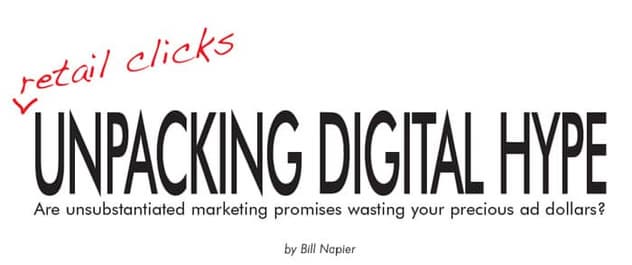
If you read the Point-Counterpoint article, "How Much is Too Much Digital" in the July/August edition of Furniture World (https://www.furninfo.com/Digital%20Editions), you already know that over 75 percent of people think that retail digital advertising is intrusive. Now add this to the mix. Maybe the metrics detailing how many likes/follows and clicks you are getting are fraudulent.
For close to two years I’ve been inundated with sales pitches from marketing companies about the next best digital marketing platforms that promise to help retailers and their industry suppliers' brands get the most out of the web to show more, tell more, and most of all sell more. I’ve been VERY suspicious about digital marketing claims for years.
Proctor & Gamble Cuts Digital Budget
These suspicions started to come into focus on July 17, 2017 when The Wall Street Journal posted a headline that Proctor & Gamble, the world’s largest advertiser, announced it was cutting $100MM from its digital ad budget because this portion of their ad spend was less than effective. Add this announcement to the fact that Ad Blockers are growing at double digit rates and you’ll hopefully approach digital marketing claims with a similar degree of skepticism.
Buyer Beware?
Remember the adage from the retail marketing pioneer John Wanamaker – “Half the money I spend on advertising is wasted; the trouble is I don't know which half”. This quip may be truer today than at the turn of the century when he was in the furniture business.
What's The ROI?
With so many companies out there promoting the next best digital marketing fad, I asked myself this question: What is the ROI reality of digital ad driven companies? I always hear the words/statements “We Increased Conversions by XXX percent." Conversions are clicks that can be manipulated. I'm not saying that every or even most digital ad driven companies are cooking the numbers, but it's recently come to light that digital is riddled with potential ad fraud that's difficult to detect. And, here is why and how it’s done.
According to Business Insider, a study commissioned by advertising giant WPP, clicks automatically generated by bots, could reach $16.4 billion in 2017 and could reach over $50 billion in 2025. Hey, this fraud and the associated profits are second only to organized crime’s drug trade!
But that’s not all. Adloox conducted its study across 200 billion daily bid requests, four billion ad calls, and 10 billion ad impressions a month, over a period of 12 months.
Across the 200 billion bid requests, 50 percent were detected as being either non-human traffic (either a bot or a hijacked device) or fraudulent traffic, which includes bad actors trying to spoof real web domains to attempt to pass off to ad buyers as premium publishers.
Google Issues Refunds
Even Google admits this is a problem and recently announced it will issue refunds to advertisers for ads bought through its platform that ran on sites with fake traffic. Google has informed hundreds of marketers and ad agency partners about the issue with invalid traffic, known in the industry as “ad fraud.” The ads were bought using the company’s DoubleClick Bid Manager.
Google’s refunds amount to only a fraction of the total ad spending affected by invalid traffic, which has left some advertising executives unsatisfied, the people familiar with the situation said. Google has offered to repay its “platform fee,” which ad buyers said typically ranges from about seven percent to 10 percent of the total ad buy.

Larger marketers are catching on. In July 2017, the Wall Street Journal reported, "Procter & Gamble Co. said that its move to cut more than $100 million in digital marketing spend in the June quarter had little impact on its business, proving that those digital ads were largely ineffective."
Ad Fraud Is Not Illegal
One of the biggest reasons digital fraud is so rampant is simply that it’s not illegal. Unlike credit card fraud, bank fraud and false advertising, nobody goes to jail for digital advertising fraud. It’s not exactly the sort of activity that elicits a crackdown from law enforcement, which means there is significantly less risk involved. And yet it’s extremely lucrative.
So what are the two main culprits?
1. CLICK FARMS: Click Farms are usually located in developing countries with very low wage rates, such as the Philippines, India, and Bangladesh, among others. Many use proxy servers or VPN.
Workers are paid low amounts, perhaps one dollar for a thousand Facebook Likes. Most probably they earn about $300 to $400 a year. Click Farms then sell their likes and followers at a much higher price.
You can check this yourself. Just Google the words “Buy Facebook likes” and you’ll find several companies listing prices. They include Buy Cheap Social at $16 for 1,000 ‘real human likes’; BoostLikes at $71 per 1,000 likes; or iBuyFans with 1,000 likes for $17.99 or 10,000 for $149.99.
There are ways to check the validity of your followers. One such option is available for Twitter called Twitter Audit. I used it on my @Napier Marketing Twitter account and I’m happy to say that 98 percent of my followers are real. Among my 1,557 followers, the audit reported 16 fakes.
Even though I carefully check every request “to follow” on Twitter, it looks like I still got duped, which reaffirms my statement BUYER BEWARE!
When people follow me, I’m astounded when I see they have 100M followers, etc. Hmmmmmm I ask myself.
While doing research for this article, a website www.clickmonkeys came up #1 organically in a Google’s search. It peaked my interest.
Their marketing message to potential clients is they solicit marketers who are under pressure to have social platforms perform. If you hire them, you’ll get the clicks/followers, etc., to boost your rankings, creating a perception that you “are liked/loved”.

Their website states, "Would we be offering this service over the Internet if it weren’t legal? Hell no! Click Monkeys!!™ is a Ukrainian company and the giant tanker ship click farm we have stationed just outside U.S. waters off the coast of San Francisco is registered at a Ukrainian berth so we’re not subject to any U.S. laws!
"Over 20,000 Click Monkeys!!™ live and work aboard our click farm. They work in shifts of 5,000 24 hours a day, seven days a week, 365 days a year!! Each monkey is able to access 12 pages per minute which gives us incredible traffic potential, just look at this math: 1 monkey x 1 hour = 720-page views/clicks. 1 monkey x 1 day = 17,280-page views/clicks. 5,000 monkeys x 1 day 86,400,000 page views/clicks!!!!"
2. BOTS. A recent article in ADWEEK noted, “Online ad fraud driven by bots will cost brands $7.2 billion globally this year, according to a forecast in a new joint study by the Association of National Advertisers and White Ops. That's up from the $6.3 billion the two organizations predicted in a similar report for 2015.
What is a BOT? According to ZVELO, a company that provides web filtering, brand safety, traffic quality analysis, contextual targeting, subscriber analytics and ad fraud prevention, “Ad fraud happens when a bot attempts to imitate legitimate web traffic (acting like a real person visiting a website) and generates additional (but fraudulent) web page views (and therefore revenue) for the website publisher. The advertisers’ budgets are compromised, as their dollars are being wasted on ads being served to bots rather than humans. This results in the advertisers and the end users paying the price for this fraud, as well as being exposed to the risks associated with malicious and fraudulent bots. Recent estimates have put the cost of Ad fraud at 20-30 percent or more of the online advertising spending, or several billion dollars a quarter."
Tactics Deployed By Ad-Fraud Bots
Tactics used by bots according to ZVELLO include:
- "Re-targeting Fraud: This bot can mimic a human’s intentions, such as an interest in a specific brand of car. Ads targeted to a particular niche result in a higher CPM than un-targeted ads. These bots deceive advertisers into believing they are receiving valuable, targeted traffic and clicks."
- "Sophisticated Fraud: This type of bot travels around the web visiting websites, viewing ads and clicks using sophisticated algorithms. Think of it as a digital ghost that is always boosting the click-through numbers.
- "Ad-fraud Botnets: These bots run quietly in the background of infected computers without making their presence known to the owner. Then, under the hacker’s remote control, the botnet — which can be rented through black-market Internet forums — is directed to visit certain websites. The most sophisticated bots are programmed to click from one website to another, watch videos for their duration, and even add items to an online shopping basket."
Advertising Age reported that for "Every $3 Spent on Digital Ads, Fraud Takes $1."
The "Hits" Keep Coming In
AdNauseam(https://adnauseam.io) a company, under the guise of "DOING GOOD" actually does really bad things to your ad budget. Their landing page states, “As online advertising becomes ever more ubiquitous and unsanctioned, AdNauseam works to complete the cycle by automating Ad clicks universally and blindly on behalf of its users. Built atop uBlock Origin, AdNauseam quietly clicks on every blocked ad, registering a visit on ad networks' databases. As the collected data gathered shows an omnivorous click-stream, user tracking, targeting and surveillance become futile."

AdNauseam was recently banned by Google on Chrome. It is a free browser extension designed to obfuscate browsing data and protect users from tracking by advertising networks. At the same time, AdNauseam serves as a means of amplifying users' discontent with advertising networks that disregard privacy and facilitate bulk surveillance agendas.
AdNauseam joins a broader class of technical systems that attempt to serve ethical, political, and expressive ends. In light of the industry's failure to self-regulate or otherwise address the excesses of network tracking, AdNauseam allows individual users to take matters into their own hands, fighting back against unidirectional surveillance. Taken in this light, the software follows an approach similar to that of TrackMeNot, employing obfuscation as a strategy to shift the balance of power between the trackers and the tracked.
What Can You Do?
First, focus on real people. Email campaigns and digital marketing companies that focus on a users' IP address that can marry that information to a real home address and prove it. There are companies out there like El-Toro. I’ve been talking to them for a year, and their case studies in the furniture industry have me convinced they have a better mousetrap. Why? Because they hate “click marketing” and their case studies show successes in sales dollars vs. spend, instead of the ubiquitous Clicks/Conversions vs. sales dollars spent.
Second, make sure that whomever is running your digital campaigns “prove to you” that the traffic generated is real.
If you Google Digital Ad Auditing, you’ll find 3,600,000 results.
If your digital ad company doesn’t give you a full audit, RUN. If their audit shows a percentage of potential BOT/Click Farm Fraud, make sure you get a credit back for that percentage.
In summary, home furnishings retailers should be skeptical when a marketing person pitches information on the newest/coolest digital marketing technique without providing due diligence. Don't get talked into adopting a platform that has the potential to waste precious advertising dollars on the newest supposed best way to attract and engage customers. Website stats can be reported in a number of ways that can be confusing. Finally, there are new and traditional programs that do get response, that do work, so don't be discouraged.
Note: Information shared from www.ZVELO.COM was used with permission.